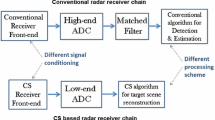Abstract
Space-time adaptive processing (STAP) is a processing technique operating in the space-time domain that allows the simultaneous cancellation of clutter and jamming via the computation of a 2D cancellation filter.
Access this chapter
Tax calculation will be finalised at checkout
Purchases are for personal use only
Similar content being viewed by others
References
K. Cain, C. Torres, and R. Williams, “Rt-stap: Real-time space-time adaptive processing benchmark,” 1997.
Wikipedia, “Cholesky decomposition,” http://en.wikipedia.org/wiki/Choleskydecomposition, 2012. [Online]. Available: http://en.wikipedia.org/wiki/Choleskydecomposition
J. Choi, J. Dongarra, L. Ostrouchov, A. Petitet, D. Walker, and R. Whaley, “The design and implementation of the scalapack lu, qr and cholesky factorization routines,” 1994.
E. Rothberg and R. Schreiber, “Improved load distribution in parallel sparse cholesky factorization,” in In Proceedings of Supercomputing ’94, 1994, pp. 783–792.
E. Rothberg and A. Gupta, “An efficient block-oriented approach to parallel sparse cholesky factorization,” pp. 1413–1439, 1994.
E. Lenormand and G. Edelin, “An industrial perspective: a pragmatic high-end signal processing design environment at thales,” in In proceedings of the Workshop on Systems, Architectures, Modeling and Simulation SAMOS, 2003, pp. 52–57.
SILKAN, http://www.par4all.org/, 2012. [Online]. Available: http://www.par4all.org/
MINES-ParisTech, “PIPS,” http://pips4u.org, 1989–2009, open source, under GPLv3.
Acknowledgements
This work also relies on the following Embedded Systems Lab’s members: Teodora Petrisor (application modeling), Remi Barrere (tool enhancements, IR1 code generation), Paul Brelet (IR2 code generation) and Eric Lenormand (map**). Claudia Cantini wishes to thank Prof. Marco Vanneschi and the Parallel Computing Laboratory of the Computer Science Department of the University of Pisa.
Author information
Authors and Affiliations
Corresponding author
Editor information
Editors and Affiliations
Rights and permissions
Copyright information
© 2014 Springer Science+Business Media New York
About this chapter
Cite this chapter
Barreteau, M., Cantini, C. (2014). Signal Processing: Radar. In: Torquati, M., Bertels, K., Karlsson, S., Pacull, F. (eds) Smart Multicore Embedded Systems. Springer, New York, NY. https://doi.org/10.1007/978-1-4614-8800-2_7
Download citation
DOI: https://doi.org/10.1007/978-1-4614-8800-2_7
Published:
Publisher Name: Springer, New York, NY
Print ISBN: 978-1-4614-8799-9
Online ISBN: 978-1-4614-8800-2
eBook Packages: EngineeringEngineering (R0)




